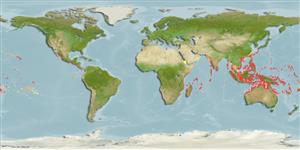Environment: milieu / climate zone / depth range / distribution range
Ecologia
marinhas associadas(os) a recifes; intervalo de profundidade 20 - 40 m (Ref. 1602), usually 20 - ? m (Ref. 1602). Tropical; 30°N - 24°S
Indo-West Pacific.
Tamanho / Peso / Idade
Maturity: Lm ? range ? - ? cm
Max length : 16.0 cm TL macho/indeterminado; (Ref. 4421)
Espinhos dorsais (total) : 1 - 2; Raios dorsais moles (total) : 30 - 33; Espinhos anais: 0; Raios anais moles: 27 - 30. Blackish brown or bluish black head and anterior portion of body, rest of the body orange. A black blotch surrounding the gill opening. Caudal fin orange; soft dorsal and anal fins yellow; first dorsal spine blackish brown. Pelvic rudiment large not broadly attached to posterior margin of ventral flap. Scale ridge rugosities of male usually develop at about 65 mm SL. Scale spinulation on midbody not closely packed.
Inhabits clear coastal reefs and protected outer reef habitats with rich invertebrate growth (Ref. 48637). Prefers deeper reefs. Often in pairs (Ref. 9710). Sometimes solitary (Ref. 90102). Secretive, adults are usually in pairs (Ref. 48637).
Life cycle and mating behavior
Maturidade | Reprodução | Desova | Ovos | Fecundidade | Larvas
Hutchins, J.B., 1986. Review of the monacanthid fish genus Pervagor, with descriptions of two new species. Indo-Pac. Fish. (12):35 p. (Ref. 527)
Categoria na Lista Vermelha da IUCN (Ref. 130435: Version 2024-2)
Ameaça para o homem
Harmless
Utilização humana
Pescarias: pouco comercial; Aquário: Espécies comerciais
Ferramentas
Relatórios especiais
Descarregue XML
Fontes da internet
Estimates based on models
Preferred temperature (Ref.
123201): 24.9 - 29, mean 27.8 °C (based on 316 cells).
Phylogenetic diversity index (Ref.
82804): PD
50 = 0.5039 [Uniqueness, from 0.5 = low to 2.0 = high].
Bayesian length-weight: a=0.01995 (0.00956 - 0.04164), b=2.93 (2.76 - 3.10), in cm total length, based on LWR estimates for this (Sub)family-body shape (Ref.
93245).
Nível Trófico (Ref.
69278): 2.9 ±0.4 se; based on size and trophs of closest relatives
Resiliência (Ref.
120179): Elevada, tempo mínimo de duplicação da população menor que 15 meses (Preliminary K or Fecundity.).
Fishing Vulnerability (Ref.
59153): Low vulnerability (10 of 100).
Nutrients (Ref.
124155): Calcium = 68.7 [29.0, 170.0] mg/100g; Iron = 0.778 [0.357, 1.813] mg/100g; Protein = 17.9 [15.7, 20.1] %; Omega3 = 0.109 [0.051, 0.224] g/100g; Selenium = 30.6 [14.7, 70.2] μg/100g; VitaminA = 66.6 [18.2, 244.0] μg/100g; Zinc = 1.51 [0.98, 2.40] mg/100g (wet weight);
